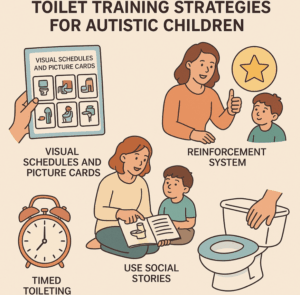Toilet Training in Autism: Practical Strategies That Work
🚽 Why Toilet Training Is Challenging in Autism
Toilet training is a key life skill, but many parents of autistic children find it especially stressful. That’s because children with autism may struggle with:
-
Sensory sensitivities (to sound, texture, smell)
-
Understanding body signals
-
Fear of new routines or places
-
Communication delays
-
Resistance to change or unexpected transitions
It’s not about laziness or parenting style—it’s about neurodevelopmental differences.
📍 When Should You Start?
There is no fixed age. Most neurotypical children start around 2–3 years. In autism, it’s okay if readiness appears later—4 or even 5 years old is not unusual.
Signs of readiness:
-
Stays dry for 1–2 hours
-
Shows discomfort when wet or soiled
-
Can follow 1–2 step instructions
-
Can sit on a potty/toilet for a few minutes
-
Shows interest in bathrooms, flushing, etc.
🛠️ Toilet Training Strategies for Autistic Children
1. Visual Schedules and Picture Cards
Use step-by-step visual cues:
-
Go to bathroom
-
Pull pants down
-
Sit on toilet
-
Pee/poop
-
Wipe
-
Flush
-
Wash hands
Laminated charts with pictures help reduce anxiety and increase predictability.
2. Use Social Stories
Create short stories that explain toilet use in simple language and images. For example:
“Sometimes my tummy feels funny. That means I need to poop. I go to the bathroom and sit on the toilet. I feel better after.”
3. Timed Toileting
Take the child every 1.5–2 hours to sit for 5 minutes—even if they don’t eliminate. Use a timer, visual clock, or favorite song for structure.
4. Reinforcement System
-
Immediate praise or reward (sticker, token, favorite snack)
-
Avoid punishment for accidents—use redirection
-
Celebrate small steps: even sitting on the toilet is a win!
5. Use the Same Toilet Initially
If the child has sensory issues, changes in toilets, seats, or lights can be distressing. Stick to one bathroom and allow familiar objects (e.g., toy, cushion, non-slip mat).
6. Dress Practically
Use elastic waist pants or adaptive clothing that’s easy to remove quickly. Avoid zippers, belts, or overalls during training.
🧠 For Sensory Sensitivities
-
Noise sensitivity: Use soft-close lids, cover flushing sounds
-
Touch aversion: Use soft toilet paper or wet wipes
-
Fear of falling: Try child-sized seat inserts with foot support
-
Resistance to bathroom smell or lighting: Use mild air freshener and dim lights
💬 Real-Life Example
Ayaan, age 4, was nonverbal and resisted sitting on the toilet. His mother used a visual chart and a social story, paired with a musical timer. Gradually, he started sitting without protest—and by 5, was independently using the toilet with minimal reminders.
📌 Common Mistakes to Avoid
-
Starting too early due to peer pressure
-
Forcing or scolding
-
Comparing with siblings or cousins
-
Ignoring sensory aversions
-
Being inconsistent across school and home
📍 Dr. Srinivas Rajkumar T
Consultant Psychiatrist – Child, Adolescent & Geriatric Psychiatry
Apollo Clinics Velachery & Tambaram | Mind & Memory Lab
🌐 www.srinivasaiims.com | 📞 +91 85951 55808
Offering parent training programs, structured behavioral plans, and sensory-aware autism care.
